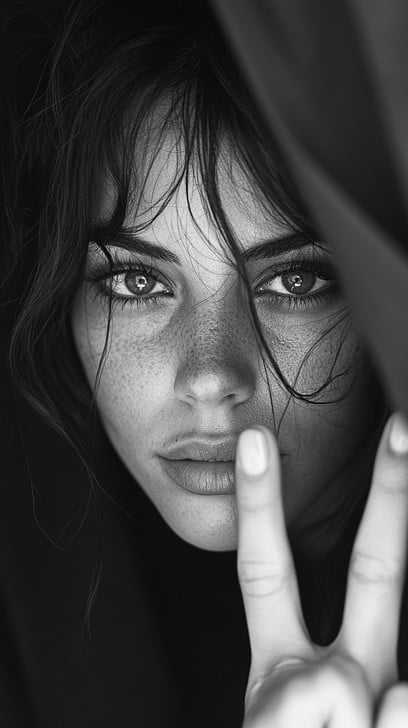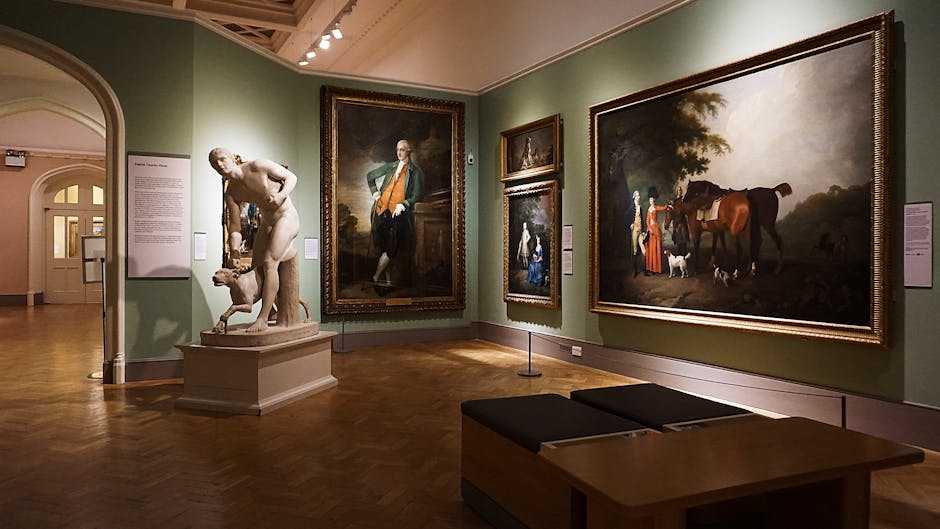Table of Contents
- Understanding the Art of Portrait Painting Techniques
- Exploring the Emotional Depth Captured in Portraiture
- Selecting the Perfect Medium for Your Portrait Creations
- Tips for Displaying and Preserving Portrait Paintings
- Q&A
- Final Thoughts
Understanding the Art of Portrait Painting Techniques
Portrait painting is a captivating practice that intertwines skill, observation, and interpretation. One foundational technique is drawing the likeness. Understanding the proportions of the face is essential, as it ensures that each feature is accurately represented. Artists often begin with a light sketch, mapping out critical points such as the position of the eyes, nose, and mouth, using a grid method or freehand techniques. This initial step establishes a solid foundation, allowing for adjustments and refinements throughout the painting process.
Another important element is color theory. Selecting the right palette can evoke emotions and convey depth. Portrait painters frequently utilize a combination of skin tones, mixing pigments such as yellow ochre, cadmium red, and titanium white to create realistic tones. Incorporating techniques like glazing—applying thin layers of transparent paint—can add dimensionality and warmth. This layering effect not only enhances the realism but also allows the artist to build a unique personality into the portrait.
Brushwork is a defining characteristic of portrait painting. Different techniques can yield vastly different results. For instance, using a soft brush for blending helps achieve smoother transitions in skin tones, whereas a stiffer brush can add texture and definition in areas like hair and clothing. The choice of brushplays a crucial role in conveying the subject’s character and mood. Artists might experiment with various strokes, employing techniques such as dry brushing for highlights or fat over lean for building texture without risking cracking in oil paintings.
Composition in portraiture is pivotal. It involves the arrangement of the subject within the frame to guide viewer engagement. While a traditional centered composition might focus on the subject’s face, artists often explore asymmetrical placements to inject dynamism. Using tools like the rule of thirds can enhance visual interest, while backgrounds can either complement or contrast the subject, adding depth. A well-considered composition not only enhances the aesthetic appeal but also reinforces the narrative inherent in the portrait.


Exploring the Emotional Depth Captured in Portraiture
The power of portraiture lies not only in its ability to capture physical likeness but also in its profound capacity to convey a spectrum of emotions. Each brushstroke has the potential to evoke feelings, narrate stories, and connect with viewers on a deeply personal level. Artists meticulously choose expressions, postures, and even color palettes to communicate a subject’s inner world. This emotional depth transforms mere depictions of people into compelling insights into human experience.
When appreciating portraits, consider how artists use various techniques to enhance emotional resonance. For instance, light and shadow can add drama or softness to a subject’s face, while color choices can reflect mood—from the warmth of earth tones to the coolness of blues. The background elements in portraits often serve as mirrors to the subject’s personality or circumstances, further enriching the narrative. The combination of these factors creates a multi-layered experience for viewers, allowing them to feel the weight of joy, sorrow, contemplation, or spontaneity.
Achieving emotional depth in portraiture can also hinge on the connection established between the artist and subject. Artists often engage with their subjects to elicit genuine emotion, an approach that can lead to stunning portrayals infused with authenticity. In this light, many portraits become windows into intimacy and vulnerability, revealing aspects of the human condition that resonate long after the viewer departs from the artwork’s presence.
To exemplify the varied emotional landscapes captured in portraiture, consider the following examples of famous paintings and the feelings they evoke:
| Art Piece | Artist | Emotional Impact |
|---|---|---|
| The Girl with a Pearl Earring | Johannes Vermeer | Mystique and Intrigue |
| Self-Portrait with Bandaged Ear | Vincent van Gogh | Isolation and Pain |
| American Gothic | Grant Wood | Stoicism and Resilience |
Through these masterpieces, viewers can explore their own emotional responses while grasping the artist’s intention. Each portrait serves as a reminder of the essential human experience — one that is rich, complex, and universally relatable, inviting reflective contemplation and engagement.


Selecting the Perfect Medium for Your Portrait Creations
Choosing the right medium for your portrait artworks can significantly shape the emotion and depth of your creations. Each medium carries its own unique characteristics, allowing for various expressions and styles. Consider your artistic goals and the atmosphere you wish to convey. Popular options for portrait painting include:
- Oil Paints: Known for their richness and vibrancy, oil paints allow for smooth blending and layering. The slow drying time gives artists the flexibility to work and rework areas until satisfied with the outcome.
- Acrylics: A versatile choice, acrylics dry quickly and can mimic the appearance of oil or watercolor paints. Their adaptability makes them ideal for both detailed and abstract portraits.
- Watercolors: Best for soft, ethereal looks, watercolors can capture delicate tones and quick brush strokes. They work well in expressive portraits, especially when conveying emotions.
- Pastels: Offering a silky texture, pastels create vibrant colors and can be blended easily. They are perfect for combining drawing and painting elements into your portrait work.
Another important factor to consider is the surface on which you will be painting. The choice of canvas, paper, or board can dramatically influence the final piece. Each option provides different textures and resilience, catering to various techniques:
| Surface Type | Best Suited For | Texture |
|---|---|---|
| Canvas | Oil and Acrylic Portraits | Variable (from smooth to rough) |
| Watercolor Paper | Watercolor Portraits | Textured, often cold-pressed |
| Wood Board | Mixed Media and Pastels | Smooth, ideal for detailed work |
Ultimately, the perfect medium should resonate with your personal style and the message you wish to communicate through your art. Don’t hesitate to experiment with different combinations. Mixing various mediums can lead to innovative results and broaden your creative possibilities. As you explore, take notes on each experience, as they will help refine your process and build a personal connection with your work.


Tips for Displaying and Preserving Portrait Paintings
Displaying portrait paintings requires a delicate balance of aesthetics and practicality. The first step is to choose the right location in your space. Consider places where natural light can enhance the colors without causing damage. Although sunlight can bring warmth to a room, it can also fade paintings over time. Positioning your portraits on a wall that receives diffused light or using protective glass can help retain their vibrancy.
When it comes to framing, opt for high-quality materials that complement the artwork rather than overshadowing it. Matte or wood frames often work well to enhance the traditional appeal of portraiture. Secure the artwork properly within the frame to prevent fluctuations in temperature and humidity from causing damage. Remember that the choice of frame can alter the overall impression, so select a design that harmonizes with your decor while respecting the painting’s style.
Preserving your portraits goes beyond just displaying them beautifully. Regular maintenance is crucial to ensure their longevity. Dust can accumulate over time, so gently clean the surface with a soft, dry cloth. Avoid using cleaners that may contain harsh chemicals, as these can cause irreversible damage. Storing art in climate-controlled environments protects them from moisture, which can lead to mold growth and other deterioration issues.
For those serious about collecting, consider using specialized protective materials. This includes UV-filtering acrylic glass, archival quality matting, and protective coatings that offer an additional layer of safeguarding. Investing in conservation resources can preserve not only the beauty of your artwork but also its value over time. Here’s a quick reference on some materials that contribute to preservation:
| Material | Benefit |
|---|---|
| UV-Filtering Glass | Reduces fading |
| Archival Matting | Prevents acid damage |
| Climate Control | Stabilizes conditions |
| Acrylic Coating | Provides protection against scratches |
Q&A
Q&A: Understanding Portrait Paintings
Q1: What is a portrait painting? A: A portrait painting is a representation of a person, typically focusing on their face and expression, though it may also include the subject’s upper body. The primary purpose of a portrait is to convey the essence, personality, and mood of the individual depicted.Q2: What distinguishes a portrait from other types of paintings? A: Unlike landscapes or abstract art, portrait paintings center on human subjects, often aiming to communicate an emotional connection or narrative about the person. The choice of colors, composition, and technique significantly contribute to the mood and interpretation of the individual.
Q3: What materials are commonly used in portrait painting? A: Artists often use a variety of materials, including oils, acrylics, watercolors, and pastels. Each medium offers a unique texture and vibrancy, allowing artists to evoke different feelings and depth in their portraiture.
Q4: How can one recognize famous portrait artists? A: Each renowned portrait artist has a distinct style. For instance, Leonardo da Vinci is known for his meticulous detail and lifelike representation, while Pablo Picasso’s approach varies dramatically, often using abstraction. Familiarizing yourself with their work, techniques, and signature styles can help you recognize their contributions to portrait painting.
Q5: What are some key techniques to consider when painting a portrait? A: Essential techniques include understanding proportions, capturing likeness through detailed observation, and using effective lighting to create depth. Artists also focus on the background, which should complement the subject without detracting from it.
Q6: How do artists convey emotion in portrait paintings? A: Emotion can be conveyed through the subject’s expressions, gaze, and posture, as well as through color choices and brushwork. An artist might use vibrant colors to express joy or muted tones to evoke melancholy, allowing viewers to feel the subject’s emotional state.
Q7: Can contemporary portraiture differ from traditional styles? A: Yes, contemporary portraiture often blends traditional techniques with modern themes and approaches. Artists may incorporate mixed media, abstract elements, or avant-garde methods to reflect contemporary society, identity, and culture, making the genre dynamic and ever-evolving.
Q8: What role do portrait paintings play in cultural identity? A: Portraits often serve as cultural artifacts, reflecting the values, power dynamics, and social narratives of the time. They can celebrate individual achievements or serve as commentaries on societal issues, thereby strengthening the connection between art and identity.
Q9: How can one start creating their own portrait paintings? A: New artists should begin by studying basic drawing techniques and practicing with live models whenever possible. Focusing on proportions and familiarizing oneself with different mediums can also help build the necessary skills to create compelling portraits.
Q10: Where can portrait paintings be appreciated today? A: Portrait paintings can be found in art galleries, museums, and private collections worldwide. Additionally, online platforms and social media allow for global appreciation and discussion, giving viewers access to contemporary portraits and emerging artists. — This Q&A encapsulates a thorough understanding of portrait paintings while engaging readers and addressing fundamental inquiries about the genre.
